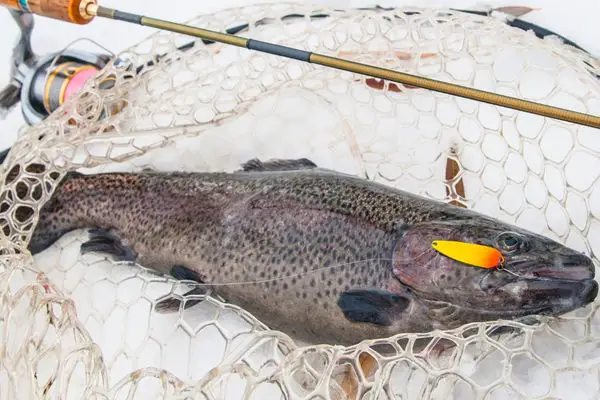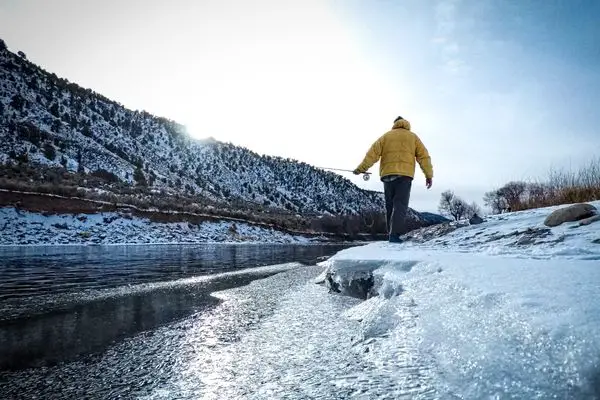Many fishermen notice that productive trout spots over the summer might seem dead during the winter. It might not just be a streak of bad luck, trout often move between home ranges. They have separate summer and winter territories.
In this guide, I will share my knowledge of where stream, river, and lake-living trout go over the winter months and the reasons for the migration. Knowing where the trout are makes them a lot easier to catch.
Trout movement over the winter months
Where do river trout go during the winter?
Water temperature and ice cover are the two main driving forces behind the movement of trout over the winter months.
In the winter, trout will relocate from their summer homes in areas of cooler water and greater flow to deeper slower flowing parts of the river. When trout fishing during the winter, it is best to concentrate your efforts on the deep holes, rather than the shallow ripples and runs.
There was an interesting study researching the movement of large brown trout in the Au Sable River, Michigan. The researchers found that the monitored large brown trout had summer and winter ranges.
During the summer, the trout home range was in a cooler, shallower part of the river. After spawning, which takes place in the fall, most of the trout traveled 10km upstream to a deeper, slower part of the river where they remained until April. This winter habitat was widely considered to be marginal for trout over the summer due to high water temperatures.
Although, such movements are not always consistent. Two studies that followed brown trout movement in an Appalachian stream and the Clinch River in Tennessee found that these brown trout did not have different winter or summer home ranges despite stressful water temperatures at times.
Trout can swim over 60 miles during the spawn!
All species of trout try to migrate to spawning streams. The exact time they decide to do so varies based on species and also river conditions. Some trout will travel many miles to find the perfect redds, while trout residents to the spawning streams might not have to leave their pool.
Broadly speaking, Brown Trout and Brook Char spawn in the fall, while Cutthroat and rainbows spawn in the spring.
Rainbows are known to delay their spawning if the water is still too cold, which means trout that live in the high mountains usually spawn later than the ones living towards the coast.
So during the spawn, where do the trout go? Well. The trout leave the larger rivers, and ponds heading towards the smaller tributary streams. The speed at which they travel does vary, but it is usually somewhere between 300 yards and 3 miles per evening.
How far the trout travel does vary greatly. I have known trout which spawned within yards of their home pool. While other trout have been documented traveling only 60 miles to reach their spawning grounds.
These trout will continue moving upstream until they reached their spawning water, or if their path is blocked by some obstacles. These obstacles can either be man-made, such as a poorly constructed dam, or natural such as low flows.
In these situations, trout often mass in large numbers just downstream. I have counted over fifty Brown Trout waiting beneath a poorly planned hydroelectric weir. It did have a retrofitted fish ladder which the trout seemed to ignore.
Others places trout are likely to wait is at the mouth of the spawning streams. In times of low flow, the trout might decide to wait at the mouth before pushing upstream to finish their spawns. Such trout at times can wait several weeks for the ideal conditions.
When in the spawning streams, the trout seek out clean gravel in the shallows. Usually in areas just beside the main flow so there is plenty of current to keep their eggs aerated. There the trout will partner out, the hen will lay her eggs and the dominant males will get to fertilize them. After spawning, brown trout do not stick around for long. Researchers have found that “brown trout returned to their pre-spawning locations within a few days after spawning.
After spawning, the trout will start to drop back downstream and put on condition. A few trout stay behind, maybe to feast on the eggs or simply because they lack the energy for the return trip.

How deep do trout hold during the winter?
Over the winter months, trout will typically spend time in the warmest water they can find. During the colder parts of the day, this could be at the bottom of deep holes, but on a warm sunny afternoon, trout that live in lakes will move to feed on shallow flats where the water is warmed by the sun.
In rivers, and streams. Expect the trout to be holding close to the bottom. Due to the influx of spring water from underground flows, the water close to the river floor can be several degrees warmer than near the surface. In addition to this, the surface layer of water also insulates against the coldest of the air.
Not only is the water warmer near the bottom, the depths also provide the trout with the majority of winter food. Other than midges, and the occasional blue wing olive hatch trout rarely have any reason to feed close to the surface. They will much rather sep stoneflies, nymphs, and the occasional worm off the bottom.
Floods can displace trout many miles downstream.
Winter storms can at times bring a lot of rain to trout fisheries often resulting in floods. These floods can displace trout several miles downstream. Trout living in gorges, or other confined watercourses are most vulnerable to displacement.
Brown and Rainbow trout do behave differently in flooded rivers. Brown trout are more likely to try and get out of the current, either sheltering in the shallows or beneath rocks. While Rainbows often try and ride out the flood fighting against the flow.
If trout are displaced, they usually end up wherever the river flow slows. This could be a large deep pool, or even a lake. So after a flood, trout are more likely to be found in slow moving parts of the river. Given time, they are likely to work their way back upstream.
I have even seen rainbow trout caught several miles out to sea, although it will be impossible to know if they were washed there or were simply following the floodwater. I know these were Rainbows and not Steelhead because they were caught in a country where anadromous rainbows/steelheads do not exist.
Trout feeding habits over the winter months
At what temperature do trout stop feeding?
As the water temperature continues to drop, the trout’s metabolism slows but they rarely stop feeding entirely. But it is not until the water temperature drops below 44f (6c) that there is a noticeable decrease in a trout’s appetite. Brook trout, Lake trout, and cutthroat trout are even hardier still.
Trout will happily continue to feed even after the surface has frozen over. With that said, in water temperatures below 44f they do become increasingly difficult to catch because their need for food is greatly reduced.
What do trout feed on during the winter?
Trout will feed on any food source that is readily available. They are not fussy. With that said, food sources are greatly reduced over the colder months compared with the summer. All aquatic life slows down.
- Nymphs
- Stoneflies
- Snails
- Eggs
- Worms
- Midges
- Blue wing olives
- Crayfish
- Shrimps
- Crabs (in tidal regions)
- Minnows
What flies to use in the winter
The best trout flies to use over winter are highly location-dependent.
When targeting raising trout, it is nearly always best to fish tiny flies that imitate midges. If you notice a mayfly hatch, then it is certainly worthwhile trying a blue wing dun imitation such as a size 18 improved sparkle dun.
When the trout are feeding sub-surface. Then a selection of nymphs, stoneflies, and egg patterns work well. Because they are likely holding close to the bottom, heavily weighted flies are often required to reach the trout’s feeding zone.
Finally, it is always worthwhile to tie on a streamer and try your luck. A plump baitfish is always a calorie-rich snack for a hungry trout.

What spinner to use in the winter?
Winter is a great time of year to dust off the spinning gear. The ability to cast further reduces the need to wading and in general, it is more active. Easier to stay warm.
When spinning for trout in cold water, slow presentation is everything. I can not stress this point enough, slow everything down. The most effective lures are the ones with the best action at a slow retrieve. So leave your roostertails and Kastmasters at home, and get out Flatfish, Rapalas, and fluttering spoons. For more examples of spinners that catch trout during the winter, check out this recent article.
I personally spend most of my time fishing jerkbaits, I have had some very productive winter fishing trips. In this this article, I explain how I catch trout on jerkbaits during the winter.
Spoons are particularly useful for targeting trout laying at the bottom of deep pools.
The next piece of advice is to fish small. Downsize, everything. Trout do not have a big appetite in the winter, so they are less willing to grab a 2-inch lure than during the warmer months.
For a more comprehensive answer on what trout eat during winter, check my guide here.
What to wear when winter fishing for trout?
Winter fishing gear serves two purposes. It must keep me warm and dry. I
If I need to enter the water, waders are excellent. Almost essential, in the winter nothing will cool your down faster than wet clothing. I personally wear Simms G4 waders, but there are plenty of cheaper options. I said waders are nearly essential, because when I am shore fishing. I can usually get away with a pair of knee-high rubber boots.
While staying dry is important, the part of my body I struggle the most to keep warm is my hands. Gloves that are thick enough to insulate, are so bulky I can not tie knots. While I struggle to stay warm in thinner gloves. I currently prefer to wear either insulated garden gloves or thick neoprene gloves. I discuss the exact glove models here.
The rest of my clothing system is mostly based on layering. I wear merino wool next to my skin, then various layers of fleece and wool overtop. The colder it gets, the more layers I wear. On windy days, I will throw on a rain jacket, just to block the breeze.
When it is extremely cold, I usually wear a down or insulated jacket. If you keep them dry they work fine, and nothing will keep you warmer. Most of them are also water resistant enough to stay warm even after an unplanned trip into the water.
If anyone looks at my photos, they will notice I often wear bright colors. Yeah, they are my ski clothing. And bright orange is probably not ideal, but I am not sure it matters that much. The snow is already extremely bright, so I tell myself that my clothing matches the brightness of the snow.


